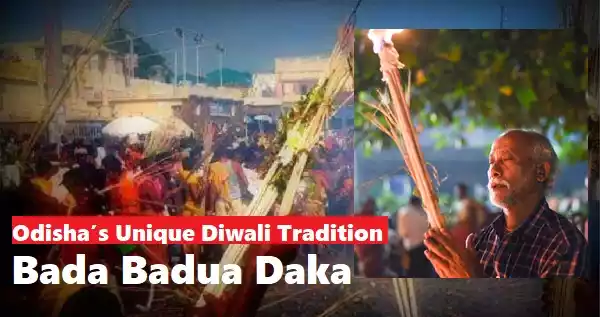Odisha’s unique Bada Badua Daka ritual honours ancestors by lighting jute sticks to guide their spirits from darkness to light. Families gather to offer prayers, seek blessings, and celebrate their heritage through this ancient tradition.
Diwali is celebrated across India through diverse customs that reflect regional identities yet share common themes of light, joy, and togetherness. Homes are decorated with lamps and rangoli, gifts are exchanged, and feasts are enjoyed. In West Bengal, the festival takes the form of Kali Puja, devoted to Goddess Kali. In Tamil Nadu, families create intricate kolam patterns, while in Goa, Diwali commemorates the defeat of the demon Narkasur.
In Odisha, however, Diwali carries a deeper spiritual layer through the Bada Badua Daka ritual. Observed on Naraka Chaturdashi (the fourth day of Diwali), it is a heartfelt practice where families light jute sticks and offer prayers to their ancestors.
Honouring Ancestors Amid the Glow of Diwali
While Diwali is widely known as the Festival of Lights, in Odisha it becomes a bridge between the living and the departed. The Bada Badua Daka tradition is an emotional moment when families symbolically invite their ancestors to partake in the joy of the festival and bless their descendants.
Although performed privately in homes, the ritual’s most striking public observance happens in Puri, in front of the sacred Jagannath Temple. Thousands gather, holding burning jute sticks in reverence, creating a mesmerizing sight of flickering flames against the night sky. It is not a tourist attraction but a deeply personal act of devotion and remembrance.
A Ritual Rooted in Reverence
At the heart of this tradition lies the burning of Kaunria Kathi (jute sticks). Families bundle and light them carefully as they chant the age-old mantra:
“Bada badua ho, andhaara re aasa, alua re jaa”
Oh ancestors, come from darkness, go towards the light.
The flames represent a guiding light, inviting ancestral souls from Pitru Lok (the ancestral realm) to move from darkness to light. The ritual beautifully mirrors the essence of Diwali itself—the triumph of light over darkness and life over death.
Purpose and Profound Significance
Bada Badua Daka is more than a ritual; it is a cultural expression of gratitude, connection, and continuity.
- Honouring Ancestors: Families pay tribute to their forebears, acknowledging their sacrifices and lasting influence.
- Seeking Blessings: The ritual serves as a humble request for divine protection, prosperity, and well-being from departed souls.
- Strengthening Family Bonds: It brings families together, reinforcing shared roots and heritage.
- Preserving Culture: By passing on this custom to younger generations, Odisha preserves its spiritual and cultural identity amid modern changes.
The Origins
Though its exact origins are uncertain, scholars trace Bada Badua Daka to around 500 years ago, possibly during the Bhakti movement led by Chaitanya Mahaprabhu. Some believe it dates even earlier, around 350 BC, connected to the Sadhabas—ancient Odia maritime traders—who prayed for safe returns from their voyages.
A Living Tradition
Even today, Bada Badua Daka remains a central part of Diwali in Odisha. The flickering light of the jute sticks continues to illuminate not just the night but the hearts of those who honour their lineage. Closely tied to Jagannath culture, the ritual reaffirms the Odia belief in unity, devotion, and eternal bonds.
In an era when modernization often overshadows age-old traditions, Bada Badua Daka stands as a living testament to Odisha’s unwavering respect for its roots. Each flame that pierces the night sky carries a message — that love, memory, and faith can bridge worlds.
FAQs
What is Bada Badua Daka?
It is an Odia ritual performed during Diwali where families light jute sticks to invite and honour their ancestors, seeking blessings and protection.
Why are jute sticks used?
Jute sticks (Kaunria Kathi) serve as symbolic torches guiding ancestral souls from darkness toward light.
When is it performed?
The ritual takes place on Naraka Chaturdashi, the fourth day of Diwali.
Where is it most observed?
While celebrated across Odisha, it is most prominent in Puri, especially near the Jagannath Temple.
What does the chant mean?
“Bada badua ho, andhaara re aasa, alua re jaa” means Oh ancestors, come from darkness and go towards the light, symbolising spiritual guidance and blessings.
Get Latest News Live on MTIMES along with Breaking News and Top Headlines, Political News and around The World.
You May Like
Trending Searches Today |
Amit Shah Pays Tribute on Hyderabad Liberation Day: Martyrs’ Courage Still Inspires India
ITR Filing Due Date Extension 2025: CBDT Extends Deadline by One More Day, How to File ITR Online
Seva Parv Special: How India Emerged as a Global Climate Champion





